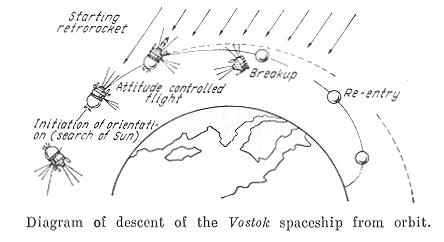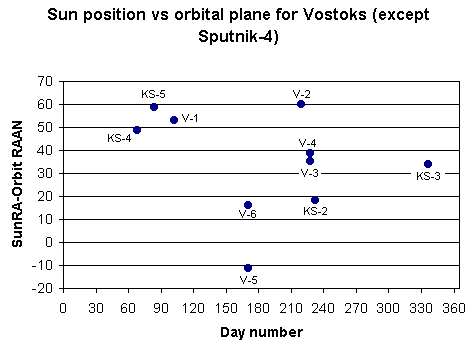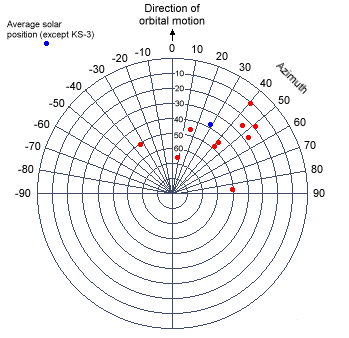 Vostok
retro-fire attitude
Vostok
retro-fire attitude Vostok
retro-fire attitude
Vostok
retro-fire attitudeThe figure on the right has been published in "The Soviet Encyclopaedia of Space Flight" (2) to illustrate the principle of orienting Vostok for retro-fire. showing just how the back-up orientation worked. It shows the spacecraft adopting the solar attitude at exit from eclipse and then keeping this until the retro impulse vector was pointing slightly downwards. In (3) we can read:
"B E Chertok was in charge of the orientation system. It consisted of two redundant systems: an automatic/solar orientation system and a manual/visual orientation system. Either system could operate two redundant cold nitrogen gas thruster systems, each with 10 kg of gas .... The automatic solar orientation system consisted of solar sensors, DUS-L2 angle of flight sensors, and an SRB analogue computer unit. The TDU would only fire if the sun sensors - consisting of a slit arranged over three photocells - indicated correct orientation. The DUS-L2 angle of flight sensor utilized two-step double gyroscopes with mechanically opposed directions. The SRB used these inputs and generated impulses to carry out the burn."In general, a single attitude sensor such as a sun sensor is not sufficient, you need at least two sensors to determine attitude (and then you may obtain two solutions and have to figure out a way to discard one). However, as Igor Lissov pointed out and Igor Yatsunskiy found out, if the sun direction coincides with the desired attitude a single sensor suffices. If you point the longitudinal axis of the spacecraft at the sun the roll orientation does not need to be controlled, only its rate.
Thus, it is interesting
to study the orientation of the sun vis-a-vis- the orbital plane and the
orbital path at the time of retro-fire for various Vostok missions.
 Summary
of sun orientation vis-a-vis the orbital plane and path
Summary
of sun orientation vis-a-vis the orbital plane and pathThe first analysis that I ran was to compare the right ascension of the sun to the right ascension of the ascending node of the orbital plane of the Vostok spacecraft at the time of retrofire. You would expect that the difference between these two numbers be zero, so that the sun would be in the orbital plane. But, as you can see from the figure below, this is not the case.
The next analysis that I
ran was to compute the azimuth and elevation of the sun at the time of
retrofire. Azimuth is defined as the position of the sun in a plane
perpendicular to the radius vector to the spacecraft. Zero-azimuth is in
the direction of flight and the positive sense is clock-wise as seen
from above (analogous to the normal definition of azimuth on the ground).
Elevation is the angle of the sun above this plane.
"Prior to the scheduled firing of the TDU-1 engine, the control group at Tyura-Tam (Group T) had detected anomalies in the primary system of attitude control, which used the infrared sensor. Although the system as a whole seemed to functioning fine, the sensor itself was not responding correctly. The Tyura-Tam team reported the problem to the control group at Moscow (Group M), but the designer of the system, Boris V. Rauschenbakh, refused to agree to Group T's recommendation to use the back-up system of orientation. OKB-1 Deputy Chief Designer Boris Ye. Chertok, who was the head of Group T, quickly called a meeting at Tyura-Tam and reached a consensus that the primary system not be used, in favour of the still-operaring solar-based Grif sensor. He then passed this recommendation on to Moscow. Although it seems that Korolev agreed with Chertok at first, he gave in after persuasive arguments by Keldysh and Rauschenbakh to go ahead with the primary system. Unfortunately, on the sixty-fourth orbit, the primary system malfunctioned and the fourteen thrusters working on compressed nitrogen inserted the spacecraft in the exact wrong attitude. The TDU-1 retrorocket automatically fired on time at 0252 hours Moscow Time, but the spacecraft, instead of re-entering the atmosphere, was boosted into a new high orbit of 305 by 690 km..."
 If
the solar orientation system had been used it would certainly have caused
the spacecraft to be oriented the wrong way (with the same orientation
of the sun sensor as implied by the sketch at the top of this page), and
at the time of retrofire the sun sensor was not possible to use as we have
seen!
If
the solar orientation system had been used it would certainly have caused
the spacecraft to be oriented the wrong way (with the same orientation
of the sun sensor as implied by the sketch at the top of this page), and
at the time of retrofire the sun sensor was not possible to use as we have
seen!
The average of all the other values of azimuth and
elevation is azimuth =
29 degrees and elevation =
38 degrees. This is marked with a blue dot in the polar plot.
Question: During braking in the segment when the RRS (Retro-Rocket System) was in operation, did the Earth run from your feet to the instruments, or did you pay attention to that?
Answer: The Earth moved a bit not from my feet to the instruments, but from my feet to the left, at an angle.
Question: What kind of angle?
Answer: It moved at an angle of about 30 degrees. ...